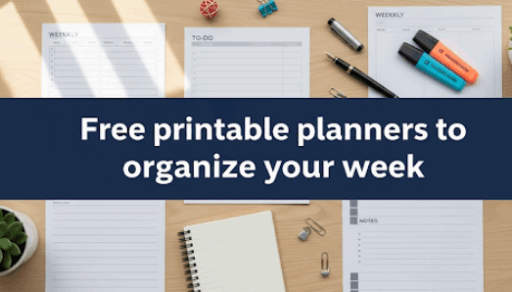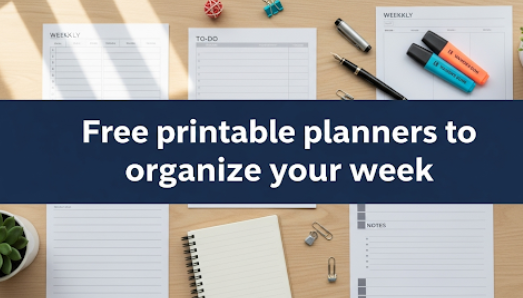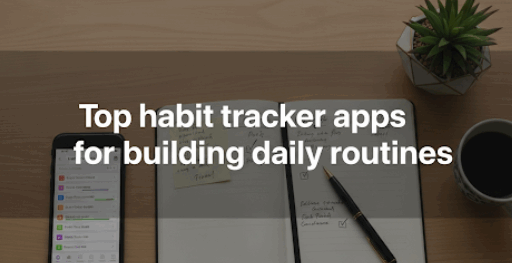Free Printable Planners: Get Your Week Under Control
Full Instructions on Better Time Management
Between schoolwork, work deadlines, family responsibilities and personal goals — life can be rather hard to handle all at once. But the answer is not to work harder, it’s using planning tools like these smarter. Luckily, free printable weekly planners make it easy and more affordable to turn chaos into clarity so you can keep on top of everything without breaking the bank.
Students can follow their busy class schedules, keeping up with extracurricular activities, working parents can stay on top of multiple schedules and those looking to improve organizational situations can benefit from using a planner that is readily provided and customizable. Printable planners allow you to experiment with different designs—not spending money on overpriced store bought stationary and not subscribing to over-priced digital organization apps—and print only what you need, to finally build a custom schedule that works for your lifestyle.
The detailed guide will show you everything about free printable weekly planners and more! From picking the best design to using them most efficiently for a productive life and inner peace.
Why Choose Free Printable Planners?
Budget-Friendly Planning Solutions
A typical planner costs between $15 to $50 or higher for a one-year supply. Printable planners can be used and reused without limit, so you will save not only money but also time as well. Print as many copies as you want, experiment with layouts without the financial risk of making a purchase, and share favorite designs with friends.
Customization Without Limits
Store-bought planners force you to adopt their templated layout and if it does not fit within your style, too bad. Printable planners give you the ability to customize:
- Page size and orientation
- Color schemes and designs
- Additional sections for specific needs
- Font sizes for better readability
- Multiple copies of busy weeks
Environmental Benefits
Buying an annual planner also leads to waste when you skip over certain months or sections, which might be better replaced by printing only what you need. Plus, you can opt for sustainable paper sources and use double-sided printing to reduce your environmental impact.
Types of Weekly Planner Layouts That Suit You
Horizontal Weekly Spreads
In horizontal layouts, they show each day of the week in columns from left to right across the page and give you a more comprehensive glimpse at your whole week. This template is most suitable for those who:
- Must compare schedules to other days
- Take appointments throughout the week
- Prefer visual timeline layouts
- Need faster ability to notice scheduling conflicts
Who this is best for: Working professionals, students with different classes, parents coordinating family activities
Vertical Weekly Layouts
Vertical planners are slated for each day to go on top of the next, giving you more room to write out those daily details. This is perfect for when you:
- Outline each day in to-do lists
- Need space for meal planning or habit tracking
- Would rather manage one day as it comes
- Need to record longer project descriptions
Ideal for: Organized planners, project managers, people with sophisticated daily routines
Sunday vs. Monday Start Options
On which day of the week your planner pages begin has major ramifications in terms of how you use your planner.
Sunday Start Planners:
- Natural weekend planning flow
- Great for scheduling around family and religion
- Great way to get ready for next week of work
- Traditional calendar format
Monday Start Planners:
- Separates work weeks clearly
- Makes weekend days together easy to plan
- More common in business and academia
- Better work-life balance visualization
Features That a Weekly Planner Should Have
Time Blocking Sections
Time blocking takes you from vague to-do lists to specific, appointed activities. Look for planners that include:
- Hourly time slots for appointments
- Flexible user-based time slot selector
- Space devoted to both scheduled events and unscheduled tasks
- Priority indicators or color-coding areas
Goal Setting and Review Areas
A weekly planner must get the person to act in a way that moves them towards their larger goals:
- Weekly Goals: 3-5 goals you will accomplish this week (concrete)
- Top Priority Box: The biggest/crucial ones
- Weekly Reflection Space: What went well and where we can still improve
- Next Week Items: Things to keep in mind and prepare for next week
Habit Tracking Integration
Habits are more easily formed when they can be visually tracked in your weekly overview:
- Daily checkboxes for habit consistency
- Water intake or exercise tracking
- Reading or learning goals
- Self-care and wellness reminders
Notes and Brain Dump Areas
New ideas, thoughts, or tasks come up many times in the week. Effective planners include:
- Lined or dotted note sections
- Quick capture spaces for random thoughts
- Contact information boxes
- Important reminder areas
Where to Find Free Printable Planners
Popular Design Websites and Blogs
There are quite a few websites that provide large selections of free printable planners:
Productivity and Organization Blogs:
- Regularly serve you productivity expert-approved planners
- Provide specific directions for use
- Offer seasonal or themed variations
- Provide matching accessories and inserts
Design-Focused Platforms:
- Feature beautiful, professional-quality layouts
- Use different color palettes and artistic treatments
- Incorporate both minimalist & decorative styles
- Provide files in multiple formats
Educational and Professional Resources
University and School Websites:
- Academic year-focused planning tools
- Assignment tracking integrations
- Study schedule templates
- Project timeline planners
Professional Development Sites:
- Business-focused weekly layouts
- Meeting and deadline tracking
- Goal-setting frameworks
- Productivity methodology integration
Community-Created Resources
A lot of homemade planner designs are shared in online communities:
- Organizing social media groups
- Forums for productivity enthusiasts
- User-generated content on planning platforms
- Free resources from planning influencers
How to Print Your Planner: Smart Printing Tips
Paper Selection Guide
Standard Copy Paper (20lb):
- Most affordable option
- Good for testing new layouts
- Ideal as temporary or short-term solution
- Some pens may exhibit ink bleed-through
Cardstock (65-80lb):
- More durable and professional feeling
- Does not bleed with various pen types
- Good for lamination or long-term use
- Perfect for covers or highly essential pages
Premium Planning Paper:
- Focused on writing and planning
- Compatible with most pens; smooth texture
- Reduces ink bleeding and feathering
- Higher cost but top-notch efficiency
Printer Settings for Best Results
| Setting | Recommendation | Why It Matters |
|---|---|---|
| Quality | High/Best | Crisp lines & clear text |
| Paper Type | Match your actual paper | Prevents jams, better prints |
| Color | Even for B&W designs | Preserves design elements and contrast |
| Scaling | 100% (Actual Size) | Proportioned correctly |
Binding and Organization Options
Three-Ring Binders:
- Add and remove pages easily
- Can combine different planner styles
- Allows dividers and more inserts
- Portable and customizable
Disc Binding Systems:
- Professional appearance
- Pages lay completely flat
- Easy to add special inserts
- Can accommodate different paper sizes
Simple Stapling:
- Quick and inexpensive
- Well suited to weekly/monthly batches
- Compact and lightweight
- Best for consistent layout use
Creating Your Personal Planning System
Identifying Your Planning Style
Visual Planners:
- Choose bright colors and layout designs
- Leverage symbols, icons and color coding
- Use charts, graphs and visual progress tracking
- Have fun with fancy accessories and planning
Minimalist Planners:
- Focus on function over form
- Prefer clean, simple layouts
- Limit the color scheme to black and white
- Need more room to write and less distracting decor
Detail-Oriented Planners:
- Want lots of writing room for notes and details
- Divide tasks into multiple steps
- Track metrics and data points
- Prefer structured, comprehensive layouts
Flexible Planners:
- Love changing their system a lot
- Have varying schedules
- Prefer modular or customizable designs
- Need flexibility to change when required
Weekly Planning Routine Development
Sunday Planning Sessions (15-20 minutes):
- Look back at the previous week: What went well? What needs adjustment?
- Review appointments: verify times and prepare items needed
- Weekly prioritization: Select 3–5 top outcomes for the week
- Block time for big tasks
- Prep for Monday: Layout materials and design what you will have to get finished on your first day
Daily Check-ins (Five Minutes):
- Check schedule and priorities for the day
- Modify plans based on newly received information
- Identify potential scheduling conflicts
- Journal and script your morning routine to set the tone for the day ahead
Weekly Reviews (10 minutes on Friday):
- Recognize accomplishments and completed tasks
- Find workflow insights for successes and struggles
- Note lessons and conclusions
- Gather things to take into next week

Maximizing Planner Effectiveness
Color Coding Systems That Work
Category-Based Color Coding:
- Work/School: Blue
- Personal/Family: Green
- Health/Wellness: Red
- Social/Fun: Purple
- Urgent/Important: Orange
Priority-Based Color Coding:
- Must Do: Red
- Should Do: Yellow
- Could Do: Green
- Someday/Maybe: Blue
Time-Based Color Coding:
- Morning Tasks: Light colors
- Afternoon Tasks: Medium colors
- Evening Tasks: Dark colors
- Flexible Timing: Neutral colors
Task Management Integration
The Two-Minute Rule: For anything that can be done in two minutes or less, do it on the spot rather than putting it on a list. It keeps small things from taking up bulk in your planner and quick tasks still get done timely.
Priority Matrix Application:
- Quadrant 1 — Important and Urgent: Block time in your day for this
- Quadrant 2 — Important but Not Urgent: Plan focused work sessions
- Quadrant 3 — Urgent but Not Important: Delegate or batch process
- Quadrant 4 — Not Urgent and Not Important: Eliminate
Weekly Theme Days:
- Monday: Planning and administrative tasks
- Tuesday: Creative/challenging project work
- Wednesday: Meetings and communication
- Thursday: Follow-up and detailed work
- Friday: Review, cleanup, and preparation
Digital Integration Strategies
Hybrid Planning Approach:
- Digital calendar for appointments/deadlines
- Print weekly planners for detailed task organization
- Scan and digitally save past weeks for reference
- Use planner for weekly overview, phone for quick capture
Photo Documentation:
- Photograph finished weekly pages
- Establish digital databases of successful planning periods
- Share your planning strategies with others
- Create a directory of layout references for efficient operation
Common Planning Mistakes and Solutions
Overcommitment Prevention
Strategies to Overcome the Planning Fallacy: Most people underestimate time requirements and many of us seem to have something planned already for every minute of our lives. Combat this by:
- Estimating how long it will take to do something and adding 25% more time
- Scheduling buffer time
- Scheduling no more than 60% of available time to allow flexibility for unplanned disruptions
- Recording whether estimates were accurate to improve future estimates
Learning to Say No:
- Evaluate new tasks against the prioritization of existing work
- Think of your planner as a tool to see the current workload
- Master noncommittal phrases
- Remember that saying no to good things allows a yes to great ones
Consistency Challenges
Building the Planning Habit:
Week 1-2: Foundation Building
- Write down only appointments that already exist
- Don’t worry about organizing perfectly or completing fully
- Plan every day, even for a few minutes
- Reward yourself for simply remembering to check your planner
Week 3-4: System Development
- Combine appointment scheduling with task scheduling
- Try a variety of sections in your planner
- Roll out color coding or priority indicators
- Begin weekly review sessions
Week 5-8: Refinement and Optimization
- Edit your layouts based on what is successful
- Develop personal shortcuts and symbols
- Create consistent planning routines
- Refine your approach to come closer to your true system
Perfectionism Paralysis
Progress Over Perfection:
- Write with pens instead of pencils (so that you do not erase all the time)
- Realize and accept that each week will not always be the neatest
- Focus on information capture rather than handwriting
- Remember that done is better than perfect
Flexibility Within Structure:
- Keep space available in case something unexpected comes up
- Adjust your plans when necessary
- When task lists go uncrossed, don’t beat yourself up — but do something about it
- Think of your planner as a tool, not a device of judgment
From Basic to Pro Planning: Advanced Weekly Organization
Project Management Integration
Breaking Down Large Projects:
- Determine the end goal: What is a finished product?
- Major milestones: 3 to 5 key steps to keep you going
- Milestone dependencies: All tasks required before a milestone is complete
- Time assessment for tasks: Estimate how long each task will take
- Weekly progress plan: Progressive movement
Weekly Project Check-ins:
- Review progress on ongoing projects
- Identify and address obstacles
- Adapt timelines to match real progress
- Celebrate milestone achievements
Seasonal and Goal-Oriented Planning
Quarterly Planning Integration:
- Tie quarterly objectives to weekly goals
- Track annual resolutions or goals
- Plan seasonal activities and preparations
- Review and adjust long-term priorities
Themed Planning Periods:
- Health Focus Weeks: Meal planning and exercise
- Skill Development and Education Weeks
- Relationship Weeks: Spend quality time with significant people
- Organization Weeks: Declutter & system improvements
Making Planning Enjoyable and Sustainable
Personalization Ideas
Design Customization:
- Include inspirational quotes or personal photos
- Use bright colors and design elements you like
- Include stickers or decorative elements
- Create seasonal variations
Content Personalization:
- Add sections for personal interests or hobbies
- Include gratitude spots for positive reflection
- Add habit trackers for personal goals
- Include elements that inspire you
Building Long-Term Success
Monthly Planner Reviews:
- Evaluate layouts and systems that are working best
- Note patterns in productivity and challenges
- Adjust your planning to changes in your life
- Celebrate planning successes and improvements
Community and Accountability:
- Set goals with friends or family members
- Join online planning communities for inspiration
- Find an accountability partner for implementing goals
- Teach the planning skills that work in your own life
Conclusion: Start Your Journey to Better Weekly Organization Today
Free printable planners are the perfect solution to have a simple yet flexible way of planning out your week. Unlike costly planning systems or complex digital apps, printable planners allow you to experiment, customize and grow organically without spending any money or facing a learning curve.
The best planner to help you plan your week starts with the one that fits into your life now AND that you adapt as your life changes. If you are a busy person and want to create your own decent planner, here is where this planning framework comes into play: start with a basic layout that attracts you, practice creating this structure at regular intervals and slowly add functionality and complexity on top of the basics.
Good planning is all about saving time, not taking up an hour to create the perfect schedule! Whether it is performing well in school, advancing your career, strengthening relationships, or working on personal growth; a well-structured week is the foundational base to reach those mountaintop goals.
Your perfect planning system is out there, waiting to be discovered through experimentation and use. Print out a few different free printable layouts, try them for a minimum of 2 weeks each, and see what feels the best for your lifestyle and preferences.
A couple of minutes a week spent on planning might yield returns in lowered stress, better productivity, and feeling more fulfilled from what you are doing with your time. Start small, but after just a few weeks you might be surprised at the difference, not just in your schedule, but also how this helps shape your entire approach for getting things done.




